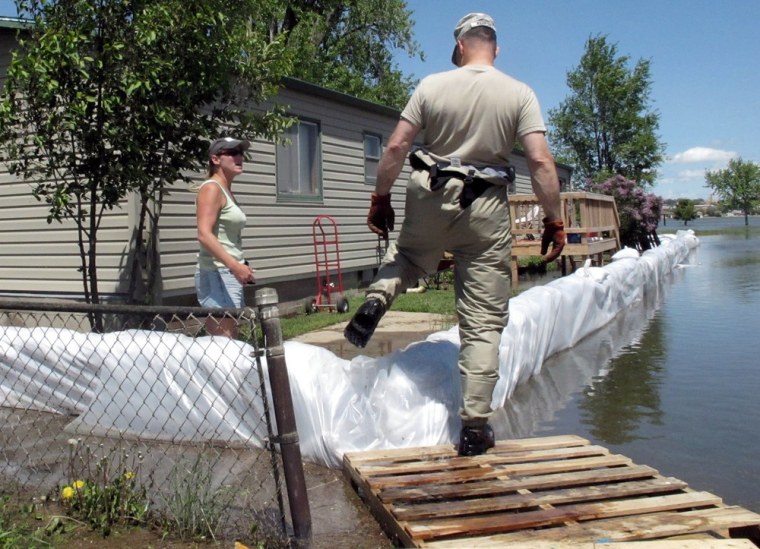Some 10,000 residents of Minot, N.D., on Tuesday were told to evacuate by Wednesday, while officials in South Dakota raced to finish levees to protect the capital and other cities from record Missouri River flows.
Mandatory evacuations were ordered for Minot residents living along the Souris River, a tributary of the Red River. The Souris is expected to eclipse peaks set in damaging floods of 1976 and 1969, officials said.
Several streets in the city of 41,000 were already under water.
Communities along the Upper Missouri River basin also are bracing for flooding as officials plan historic water releases to relieve pressure from heavy rains and a thick melting snowpack on six reservoirs from Montana through South Dakota.
Residents of North Dakota's capital, Bismarck, were working with state National Guard troops to fill and place millions of sandbags to hold the Missouri River to beat back flows from the Garrison Dam above the city.
Releases from the Garrison Dam reached record levels on Monday. Authorities went door-to-door in Bismarck neighborhoods and adjacent Mandan to encourage people to leave.
Contractors have been racing to complete levees in the South Dakota capital of Pierre and nearby Fort Pierre before federal officials rapidly increase flows from a reservoir nearing capacity upstream from those cities.
South Dakota Gov. Dennis Daugaard said construction of levees was on track to reach planned levels within two days in the capital and in Dakota Dunes, a small community near the Iowa border, but residents should be prepared for the worst.
"Residents should plan to be away from their homes for as long as two months," said Eric Stasch, operations manager at Oahe Dam upstream in north-central South Dakota.
Daugaard stressed that the 2,500 residents of Dakota Dunes were only advised to be ready and had not been ordered to evacuate.
The Missouri River is expected to rise about 8 feet from current levels when flows are brought to maximum releases from the Gavins Point reservoir by mid June. Officials plan two feet of buffer on the levees for minor water flow changes.
The pace of releases is expected to gradually increase this week, but then step-up after the weekend, eventually not quite doubling already high levels to make space in the reservoirs for additional water flowing in from the rains and thaw.
"We are hovering right around our record pool right now," said Eric Stasch, U.S. Army Corps of Engineers operations manager at the Oahe Dam above Pierre.
Contractors made good progress Monday night and through the evening in constructing levees to protect the capital and Fort Pierre, Stasch said.
Pierre and Fort Pierre residents have been bracing for days as contractors push to extend levees to meet the high waters.
"Every house has bunkers around it," Pierre resident Steve Halvorson said in a telephone interview. "The earth and berms are covered with plastic."
Halvorson, 46, who has lived 19 years in Pierre, said his house is high enough up to be protected from the rising waters, but he has brought in generators and checked sewer lines to prepare for the flooding.
"It's sobering to see what's been done and we don't even know if it's going to be effective because we've never been through this," Halvorson said.
Rain over the long holiday weekend forced water managers to increase their controlled releases from the reservoirs more quickly than previously planned. Those reservoirs control water levels all along the Upper Missouri River.
Governors from Montana, through the Dakotas and Wyoming have called up hundreds of National Guard soldiers to bag sand, assist in levee building and try to dissuade anxious property owners from navigating submerged roads and washed-out bridges.
Emergency workers also have been ferrying food and water to the small Montana town of Roundup, cut off by rising floodwaters on the Musselshell River.
In Idaho, tributaries of the Columbia River have breached their banks in the eastern and northern parts of the state, prompting the governor to declare a state of emergency.
The high water in the Columbia and Missouri basins comes after major flooding already this year of the Mississippi River in the Midwest and south to the Gulf of Mexico.
